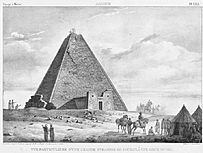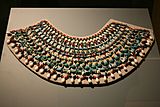Amanishakheto facts for kids
Quick facts for kids Amanishakheto |
|
|---|---|
| Kushite Queen of Meroe | |

Stele of Amanishakheto (center) from the temple of Amun in Naqa
|
|
| Predecessor | Amanirenas |
| Successor | Amanitore |
| Born | Unknown |
| Died | Unknown |
| Burial | Meroe (Beg. N 6) |
Amanishakheto was a powerful queen, known as a Kandake (meaning "Queen Mother" or "Queen Regent"), who ruled the ancient Kingdom of Kush. This kingdom was located in what is now Sudan. She likely ruled from about 10 BC to 1 AD. However, the exact dates for many Kushite rulers are not fully known. Her name in the ancient Meroitic language was "Amanikasheto." She was called "Amaniskheto qor kd(ke)," which means "Ruler and Queen."
Contents
Discovering Queen Amanishakheto
We know about Queen Amanishakheto from several important places and objects. Her name is found in the Amun-temple in Kawa. It also appears on a stone slab, called a stela, from Meroe. Inscriptions mentioning her were found in a palace building at Wad ban Naqa. Another stela from Qasr Ibrim and one from Naqa also mention her. Her pyramid at Meroe, known as Beg. no. N6, is another key site.
Amanishakheto is especially famous for a collection of beautiful jewelry. This treasure was taken from her pyramid in 1834 by an Italian treasure hunter named Giuseppe Ferlini. He damaged the pyramid while looking for its valuable contents. The treasure was amazing, including:
- 10 bracelets
- 9 shield rings
- 67 signet rings
- 2 arm bracelets
- Many amulets
These items were made by the best artists in the Kingdom of Meroë. Today, you can see these treasures in the Egyptian Museum of Berlin and the Egyptian Museum of Munich.
Art Showing Her Power
Ancient art helps us understand Queen Amanishakheto's importance.
The Sandstone Relief
A sandstone relief, which is a carved image, shows Queen Amanishakheto. It was found in the Temple of Amun in Naqa and is now in the Khartoum National Museum in Sudan. The relief shows the queen next to two gods. In ancient Egyptian art, people shown sitting down are usually the most important. Also, being taller than others in a picture often means you are more powerful.
In this relief, Amanishakheto is taller than the two figures next to her. However, the seated god would be considered even more important. The gods are identified as Amesemi and Apedemak, who were warrior gods. Amanishakheto is also wearing royal clothing. This clothing is linked to Nubian warrior and hunting gods. This shows her role as a strong protector of her kingdom. Showing the queen with these gods highlights her great power and high status.
The Stele of Queen Amanishakheto
Another important piece is a stela showing Amanishakheto with the warrior goddess, Amesemi. This stela is made from sandstone and was also found in the Temple of Amun in Naqa. Both women are wearing similar clothes. They have fitted clothing, a scarf with a tassel, a collar, and rounded wigs.
Their bodies are shown differently. The goddess has a slimmer figure with a dress that has more detailed designs. Amanishakheto is shown with a more curvy shape. The way they interact seems very close, which also suggests how powerful Queen Amanishakheto was. The ancient writing, called hieroglyphs, on the back of the stela names both women. This stela was placed in the Temple of Amun in Naqa. This temple was built after Queen Amanishakheto had passed away.
Gallery
See also
 In Spanish: Amanishajeto para niños
In Spanish: Amanishajeto para niños







